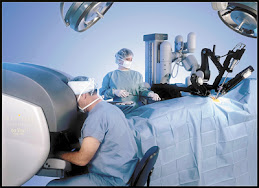In 1989 a medical robotic company called Computer Motion Inc. was born and so was surgical robotic technology. Computer Motion had the vision to revolutionize surgery by developing intelligent computerized and robotic systems to make surgeries easier for surgeons, safer for patients, and more efficient and cost effective for operating rooms (“Computer Motions”). Aesop™ was their first robot. It offered a third arm to surgeons and showed off a stable, voice-controlled high resolution endoscope. After several upgrades to the system, in 1998, the Aesop 3000 became the world’s first robot to be cleared by the FDA for surgery. This was just the beginning. Computer Motion went on to release the Hermes Control Center, the highly intelligent operating room as well as Zeus™. Zeus was the first robot used in CABG (1998) and micro-wrist and micro-joint (2001) procedures. In 1995, Intuitive Surgical, Computer Motion’s nemesis was founded. They were “the other” leader in surgical robotics based on technology from Stanford Research Institute (SRI), MIT, and IBM Corporation. They came up with the da Vinci® System, whose success we have documented in various posts. June 2001, BBC released a report that 17 patients at Rome’s Policlinico Casilino University were operated on by US surgeons thousands of miles away via robots. This “telesurgery,” involving 14 laparoscopies and 3 kidney operations was deemed a “success” despite minor complications (“Intercontinental Robotic Surgery”).
Three months later, the Zeus robotic system stunned the entire world by being used to perform a landmark overseas surgery (“Surgeons in US Perform Operation in France via Robot”). The surgeon was in New York City while the gallbladder being removed was in Strausbourg, France. After 54 minutes of surgery without complications, Zeus made a very compelling case for surgical robots.
In 2003, the two giants, Intuitive Surgical and Computer Motion, merged. This move to combine the unprecedented technology of the two companies was promised by both CEO’s to produce the best products for patients and surgeons (“March 7, 2003 – Intuitive Surgical and Computer Motion Merge”).
Surely, they have kept to their word. Since the merge, there have been many success stories. In 2005, the da Vinci system was used to remove 60% of the patient’s liver, who only needed 2 days to be cleared to go home (“First Robotic Complex Liver Surgery”). December that same year, 20% of all prostatectomy procedures in the US was performed with robots, which proved to be induce less blood loss in patients (“Cutting Edge”).
By this year, 2007, robotic surgery is used for an increasing number of different surgeries. We have documented success stories ranging from complex heart procedures (“Total Endoscopic Repair of A Pediatric Atrial Septic Defect Using the da Vinci Robot and Hypothermic Fibrillation”) to Urological microsurgery (“Robotic Assistance in Urological microsurgery”). In all cases, robotic surgery brags minimal invasiveness via operating with high resolution cameras. Patients enjoy reduced recovery time ( http://www.brightcove.tv/title.jsp?title=1213874957&channel=1184612073) and most notably with cardiothoracic surgeries where the need for a sternumectomy is hurdled by using robots to make extremely precise incisions.
While robotic surgery boasts a variety of accomplishments, there are drawbacks to this technique. The main complaint among surgeons and critics of robotic surgery is the loss of tactile sensation since the surgery isn’t being performed with the surgeons own hands. An extension of this complaint is the lack of haptics in most surgical robotic systems. Haptics is a system that recreates the feel of tissues through force feedback through robotic controls. Another major issue with robotic surgery is cost effectiveness. A typical robotic system costs $1.2-$1.5 million to purchase and a yearly maintenance cost of $100,000.
Regardless of the drawbacks to robotic surgery, it still stands that robotic surgery is the technology of the future. Nothing illustrates the amazing evolution of surgery from its messy inception to the highly sophisticated technological systems of today like robotic surgery does. Robotic surgery has expanded to include neurological, urological, cardiac, orthopedic, and gynecological functions. The benefits of robotic surgery, including but not limited to: less pain, better wound cosmesis, fewer wound complications, shorter hospital stays, and shorter recovery time, are revolutionary. In the near future, "I, Robot" will signify more than a mere movie title for many surgeons around the world.
Subscribe to:
Post Comments (Atom)

1 comment:
As a well-established Best Robotic Surgeon in Chandigarh , Dr. Anupam Goel has a career based on the promotion of minimal access surgery in India and has acquired a position of a reliable and experienced laparoscopic surgeon. His kind surgical approach, concern and obedience to patient safety and his reliability in yielding good results have assisted many patients to heal quickly. It can be a hernia repair or bariatric surgery but at any rate, Dr. Goel offers end-to-end care, that is, consultation to post-surgical recovery. His clinical and patient satisfaction awards show his leadership in the sphere of the modern surgery.
Post a Comment